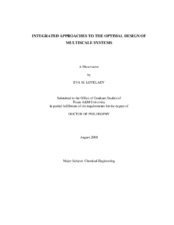| dc.description.abstract | This work is aimed at development of systematic approaches to the design of
multiscale systems. Specifically four problems are addressed: environmental impact
assessment (EIA) of new and retrofitted industrial processes, integration of process
effluents with the macroscopic environmental systems, eco-industrial parks (EIP), and
advanced life support (ALS) systems for planetary habitation. While design metrics
and specific natures of each problem poses different challenges, there are common
themes in the devised solution strategies:
a. An integrated approach provides insights unseen by addressing the individual
components of the system and, therefore, better understanding and superior
results.
b. Instead of dealing with multiple scales simultaneously, the design problem is
addressed through interconnected stages without infringing upon the
optimization degrees of freedom in each stage. This is possible through the
concept of targeting.
c. Mathematical programming techniques can be used effectively to systematize
the integration concepts, the target identification, and the design of multi-scale
systems. The dissertation also introduces the following specific contributions:
i. For EIA, a new procedure is developed to overcome the limitations of
conventional approaches. The introduced procedure is based on three
concepts: process synthesis for systematic generation of alternatives and
targeting for benchmarking environmental impact ahead of detailed design,
integration of alternative with rest of the process, and reverse problem
formulation for targeting.
ii. For integrating process effluents with macroscopic environmental systems,
focus is given to the impact of wastewater discharges on macroscopic
watersheds and drainage systems. A reverse problem formulation is
introduced to determine maximum allowable process discharges that will
meet overall environmental requirements of the watershed.
iii. For EIPs, a new design procedure is developed to allow multiple processes
to share a common environmental infrastructure, exchange materials, and
jointly utilize interception systems that treat waste materials and byproducts.
A source-interception-sink representation is developed and modeled through
an optimization formulation. Optimal interactions among the various
processes and shared infrastructure to be installed are identified.
iv. A computational metric is introduced to compare various alternatives in ALS
and planetary habitation systems. A selection criterion identifies the
alternative which contributes to the maximum reduction of the total ESM of
the system. | en |


